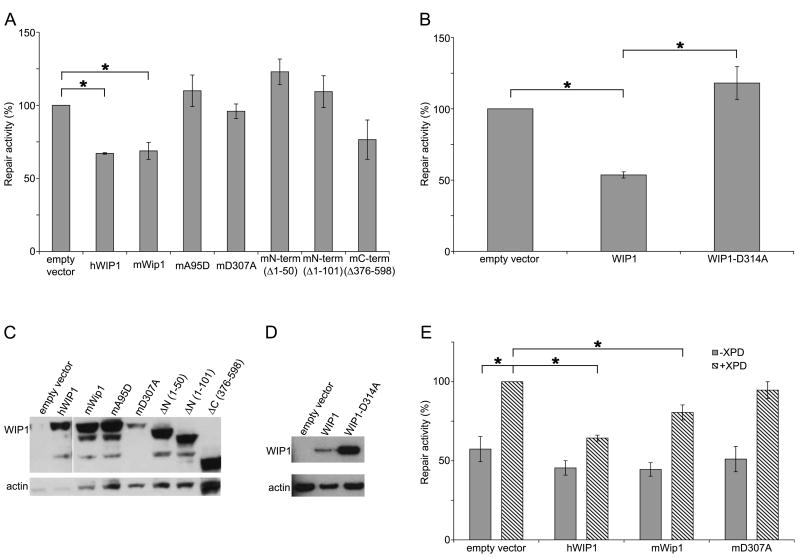Figure 2.
WIP1 inhibits NER. (A) WIP1, but not mutant murine Wip1, overexpression inhibits NER in U2-OS cells. Human WIP1, mouse (wild-type, point or truncation mutant) Wip1, or empty-CMV expression constructs were cotransfected with a UV-damaged firefly luciferase reporter plasmid and an unirradiated Renilla luciferase plasmid into U2-OS (p53 proficient cells). Twenty-four hours after transfection, the cells were harvested and luciferase activity was measured. After correcting for transfection efficiency by normalizing to firefly Renilla luciferase activity, the empty vector transfected cells were set to 100% and the normalized luciferase values for the other cells were reported as percent repair activity. Error bars indicate the standard error (n=3). Asterisks indicate statistical significance (p<0.05). (B) p53-independent inhibition of NER in Saos-2 cells by WIP1. Human wild-type or phosphatase-dead WIP1 or empty-CMV expression constructs were cotransfected with luciferase plasmids in p53 null Saos-2 cells as described above. Error bars indicate the standard error (n=4) and asterisks indicate statistical significance (p<0.05). (C) Western blot analysis of WIP1 expression in U2-OS cells transfected with human or mouse Wip1 as analyzed in (A). A monoclonal Flag or V5 antibody was used to detect human or mouse Wip1, respectively, which is the top band in each lane. β-actin was used as loading control. (D) Western blot analysis of WIP1 expression in Saos-2 cells transfected with human WIP1, as analyzed in (B). (E) WIP1 suppression of UV-damage repair is largely dependent on a functioning NER pathway. WIP1 overexpression inhibits NER in XP17BE (XPD deficient) cells complemented with an XPD plasmid. Human wild-type or phosphatase-dead WIP1 or empty-CMV expression constructs were cotransfected with luciferase plasmids in the presence or absence of exogenous XPD in XP17BE cells as described above. After correcting for transfection efficiency by dividing the firefly by Renilla luciferase activity, the empty vector + exogenous XPD transfected cells were set to 100% and the normalized luciferase values for the other cells were reported as percent repair activity. Error bars indicate the standard error (n=3). Asterisks indicate statistical significance (p<0.05).

